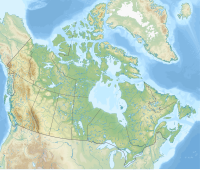| High Rock Range | |
|---|---|
 Mount Rae from the north, Sept. 2006 | |
| Highest point | |
| Peak | Mount Rae |
| Elevation | 3,218 m (10,558 ft) |
| Coordinates | 50°37′22″N114°58′29″W / 50.62278°N 114.97472°W [1] |
| Dimensions | |
| Length | 117 km (73 mi)N-S [2] |
| Width | 37 km (23 mi)E-W [2] |
| Area | 2,172 km2 (839 sq mi) [2] |
| Geography | |
| Country | Canada |
| Provinces | Alberta and British Columbia |
| Range coordinates | 50°08′56″N114°42′21″W / 50.14889°N 114.70583°W [3] |
| Parent range | Canadian Rockies |
| Topo map | NTS 82J2 Fording River [3] |
The High Rock Range is a mountain range of the Canadian Rockies in southwestern Alberta and southeastern British Columbia, Canada.
Contents
It is a part of the Southern Continental Ranges and is located on the Continental Divide, north of the Crowsnest Pass and south of the Highwood Pass. [4] It lies partly within Kananaskis Country.
The Misty Range and the Greenhills Range are subdivisions of the High Rock.
The High Rock Range covers a surface area of 2,172 km2 (838 mi2), has a length of 117 km (73 mi) (from north to south) and a width of 37 km (23 mi). [2]


